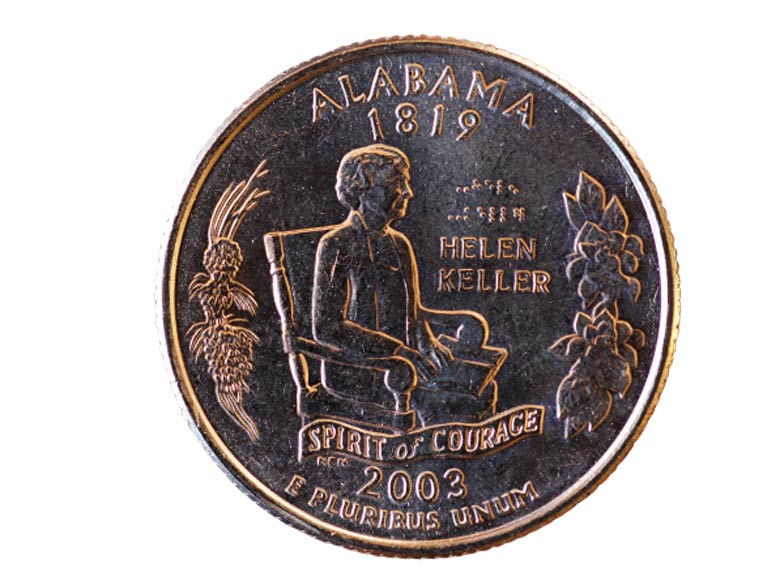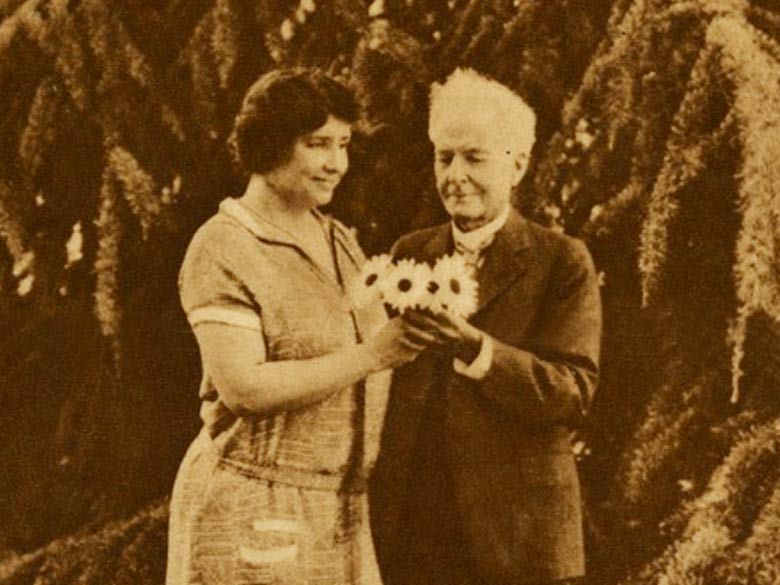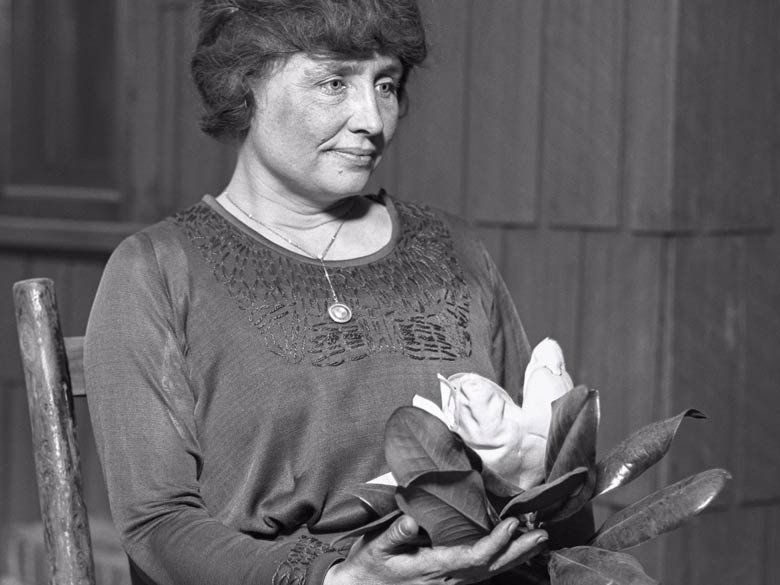“My garden is my greatest joy,” Helen Keller shared in a 1930 interview with Hazel Kinscella for Better Homes and Gardens. “I feel that I am in the seventh heaven when among my plants. I feel the little heads pop up to look at me — my poppies, pansies, and pinks.”
Every day, Helen went for a walk outside in her “green circle,” a narrow garden path lined with a hedge on one side and small evergreen trees on the other.
“It is always a miracle to see young trees grow,” she told Hazel. “I take unusual joy in the dogwood and the wisteria.”
The interview appeared later in an article entitled “Helen Keller Sees Flowers and Hears Music.”
The magic behind Helen Keller Day
Helen Keller day is commemorated every year on her birthday, June 27.
It’s a day to remember her extraordinary achievements in life, and her resilience when overcoming challenges.
We can use more inspiration, right?.
Helen Keller was an author, activist, lecturer, and advocate for people with disabilities, being deaf-blind herself.
 While Helen Keller Day is not a public holiday in the United States, the idea of a holiday to honor the life of Helen Keller was heavily endorsed by many organizations that help those with disabilities, specifically blind and deaf people.
While Helen Keller Day is not a public holiday in the United States, the idea of a holiday to honor the life of Helen Keller was heavily endorsed by many organizations that help those with disabilities, specifically blind and deaf people.
[perfectpullquote align=”full” bordertop=”false” cite=”” link=”” color=”” class=”” size=””]In spite of her physical challenges, Helen was a keen observer and was in touch with the outside world.[/perfectpullquote]
“Are all these flowers from your garden? ” Kinscella asked, impressed by the fragrance of red roses, white peonies, and other blossoms which were arranged in vases.
“Yes, indeed,” said Helen, and then added modestly, “but you must not think we have a big garden because we seem to have so many flowers. At its best, it is not much.”
[Hi, it’s Marion. This article was originally published in the Kodiak Daily Mirror, the hometown newspaper for Kodiak, Alaska. Go here to access the archive page for the list of my past columns, written each week since 1986].
Helen Keller’s favorite flowers…
“I adore the peonies,” she said. “Since my childhood, I have adored them and have been glad each spring when the miracle of their bloom has been wrought again.
“I really like no flowers without fragrance, as fragrance is their soul, to me,” said Helen. “As color is to the eye, so is fragrance to me my way of recognizing them.
“Also I feel them, their form, shape, stem, even their pistils.”
A special visit with the “Plant Wizard”
In 1925, Helen Keller visited Luther Burbank, the famous “plant wizard” at his home in Santa Rosa, California. She spent the afternoon going over many of Burbank’s plant creations using her sense of touch.
This photograph shows Luther Burbank standing in his garden shoulder to shoulder with Helen Keller. She is holding a bouquet of Shasta daisies, one of the many plants that Burbank developed.

Burbank felt that they became instant friends who understood one another.
He “saw through her fingers as much as she saw through [his] eyes.”
Of Burbank, Helen said, he has the “rarest of gifts, the receptive spirit of a child…
[perfectpullquote align=”full” bordertop=”false” cite=”” link=”” color=”” class=”” size=””]When plants talk to him, he listens. That is why they tell him so many things about themselves[/perfectpullquote]
“He encourages the plant to put forth the best of which it is capable. In the same way, he says, ‘every human being should be given a chance to grow in freedom and develop his powers according to the inner law of his nature.’”
Helen writes to Burbank
[perfectpullquote align=”full” bordertop=”false” cite=”” link=”” color=”” class=”” size=””]O, what a world this will be when men understand as you do the sweet law of growth, and express it in acts, in education, in their lives.[/perfectpullquote]
I couldn’t help myself. While writing this article, I searched for ‘Burbankisms’ in my gardening books:
[perfectpullquote align=”full” bordertop=”false” cite=”” link=”” color=”” class=”” size=””]“Flowers always make people better, happier, and more helpful; they are sunshine, food, and medicine for the soul.”[/perfectpullquote]
[perfectpullquote align=”full” bordertop=”false” cite=”” link=”” color=”” class=”” size=””]“Don’t wait for someone to bring you flowers. Plant your own garden and decorate your own soul.”[/perfectpullquote]
While Helen devoted much of her time traveling to over 40 countries, giving speeches about her life, and raising awareness to the disabilities of those that are deaf and/or blind, she also enjoyed a variety of pastimes.
“I play solitaire, sew, and embroider, I walk, we play checkers, and I read most of all. But how I love my radio, I listen to it each night.”
Helen hears music and feels color
Helen’s radio enabled her to feel beautiful music every night. Her favorite music was Wagner’s “Fire Music” and Beethoven’s “Moonlight” Sonata.
While Helen could not see color per se, she could sense them nonetheless.
“My impressions of color are emotional, symbolical. I am interested in the theory that there is a correspondence between all the colors in the visible world and the soul within.”
Overall, Helen Keller published 12 books and wrote many articles during her life. It is her autobiography “The Story of My Life”, published in 1903, that she is better known for.
Essay: Three Days to See
Another famous piece of writing of hers is the essay “Three Days to See”, where Keller imagines what she would do if she could see for three days.
It’s an extraordinary read. I encourage everyone to read it. Slowly and quietly.
You can access and download the entire Three Days to See pdf here.
“Sometimes,” she wrote, “I have thought that we should live each day as if it were our last. Most of us, however, take life for granted.”
We have much to learn from Helen Keller, who would place her hand on a small tree in order to “feel the happy quiver of a bird in song.”
“In the afternoon of that first day, I should take a long walk in the woods. I would try desperately to absorb in a few hours the vast splendor which is constantly unfolding for those who can see.”
“Perhaps this outline of how I should spend my three days of sight does not agree with the plan you would follow if you knew you were about to become blind. I am, however, sure that if you really faced that fate you would use your eyes as never before.”
[perfectpullquote align=”full” bordertop=”false” cite=”” link=”” color=”” class=”” size=””]If we could see the miracle of a single flower clearly our whole life would change.– Buddha[/perfectpullquote]
“Your eyes would touch and embrace every object that came within your range of vision. Then, at last, you would really see. A new world of beauty would open before you.”
Helen gave one hint to those who see:
[perfectpullquote align=”full” bordertop=”false” cite=”” link=”” color=”” class=”” size=””]Use your eyes as if tomorrow you would become blind.[/perfectpullquote]
She went on to encourage us to use our other senses the same way. “Hear the music of voices, the song of a bird as you would be deaf tomorrow. Touch each object as if tomorrow this sense would fail. Smell the perfume of flowers, taste each morsel, as if tomorrow you could never taste or smell again.”
As a final word, Helen offered: “Glory in the pleasure and beauty the world reveals to you through your senses. But of all the senses, I am sure that sight must be most delightful.”
Thanks for joining me. I hope you enjoyed this article. Blessings to you and your family.

A couple more resources for you:
Hi gardeners! Want to create your dream garden? You can do it, step-by-step with Marion Owen: The Gardener’s Coach. Visit my YouTube channel: The Gardener’s Coach.
Compost is the answer to everything in the garden!
And if you have enough of it, you won’t need much of anything else. To learn more, take my 60-second assessment.





2 Comments
Eva
June 27, 2022 at 4:15 AMWonderful article. So much we take for granted. Thank you for this, Marion and for the links.
Marion Owen
June 29, 2022 at 7:23 PMSo glad you enjoyed it, Eva. Blessings to you always, Marion.